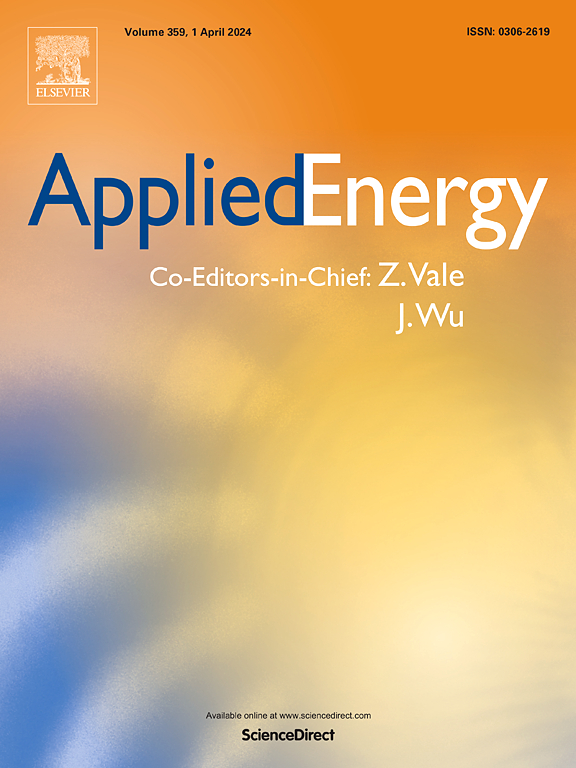Multi-output model of medium-temperature chillers for digital twins: A comparative study of steady-state and dynamic modeling approaches
IF 11
1区 工程技术
Q1 ENERGY & FUELS
引用次数: 0
Abstract
Chiller modeling is essential for ensuring efficient chiller operation. The existing chiller models are mostly single-output steady-state models that cannot accurately capture the dynamic behavior of chillers and cannot meet the needs of digital twins. In this work, a multi-output model framework was proposed to facilitate the development of a digital twin chiller. Subsequently, three steady-state and three dynamic chiller models were developed based on a medium-temperature case. The hyperparameters of the six candidate models were optimized. To systematically evaluate model suitability, we introduced two novel metrics: the univariate error, which quantifies prediction accuracy for individual variables, and the model overall error, which aggregates errors across all variables to assess comprehensive performance. A comparative analysis was then conducted to contrast the best steady-state and dynamic models, evaluating their overall error and dynamic responsiveness. The study results show that: The chiller power consumption of all models exhibit the lowest prediction accuracy, followed by evaporator outlet water temperature and condenser outlet water temperature. The support vector regression (SVR) model is the best of the steady state models with model overall error of 10.84 %, and the gate recurrent unit (GRU) model is the best of the steady state models with model overall error of 3.67 %. Notably, the GRU model demonstrates superior accuracy in predicting evaporator outlet temperature(), condenser outlet temperature( and chiller power consumption( and better captured transient fluctuations in these variables during chiller start-up and load changes compared with the SVR model. The findings provide a methodological foundation for developing digital twin models and optimizing intelligent operation/maintenance strategies for chillers.
数字双胞胎中温制冷机多输出模型:稳态和动态建模方法的比较研究
冷水机组建模是确保冷水机组高效运行的必要条件。现有的冷水机组模型多为单输出稳态模型,不能准确地捕捉冷水机组的动态行为,不能满足数字孪生的需要。在这项工作中,提出了一个多输出模型框架,以促进数字双冷水机的开发。在此基础上,建立了中温工况下的三种稳态和三种动态制冷机模型。对6个候选模型的超参数进行了优化。为了系统地评估模型的适用性,我们引入了两个新的指标:单变量误差,用于量化单个变量的预测准确性;模型总体误差,用于汇总所有变量的误差以评估综合性能。然后对最佳稳态和动态模型进行了对比分析,评估了它们的总体误差和动态响应性。研究结果表明:各模型对冷水机组耗电量的预测精度最低,蒸发器出口水温次之,冷凝器出口水温次之。支持向量回归(SVR)模型是稳态模型中最好的,模型总体误差为10.84%,门递归单元(GRU)模型是稳态模型中最好的,模型总体误差为3.67%。值得注意的是,与SVR模型相比,GRU模型在预测蒸发器出口温度(Teo)、冷凝器出口温度(Tco)和制冷机功耗(P)方面表现出更高的准确性,并且更好地捕获了制冷机启动和负荷变化期间这些变量的瞬态波动。研究结果为开发数字孪生模型和优化冷水机组智能运行/维护策略提供了方法学基础。
本文章由计算机程序翻译,如有差异,请以英文原文为准。
求助全文
约1分钟内获得全文
求助全文
来源期刊

Applied Energy
工程技术-工程:化工
CiteScore
21.20
自引率
10.70%
发文量
1830
审稿时长
41 days
期刊介绍:
Applied Energy serves as a platform for sharing innovations, research, development, and demonstrations in energy conversion, conservation, and sustainable energy systems. The journal covers topics such as optimal energy resource use, environmental pollutant mitigation, and energy process analysis. It welcomes original papers, review articles, technical notes, and letters to the editor. Authors are encouraged to submit manuscripts that bridge the gap between research, development, and implementation. The journal addresses a wide spectrum of topics, including fossil and renewable energy technologies, energy economics, and environmental impacts. Applied Energy also explores modeling and forecasting, conservation strategies, and the social and economic implications of energy policies, including climate change mitigation. It is complemented by the open-access journal Advances in Applied Energy.
 求助内容:
求助内容: 应助结果提醒方式:
应助结果提醒方式:


